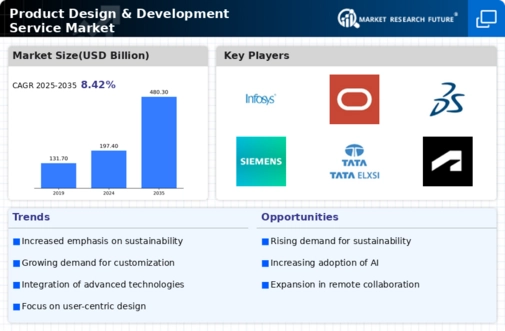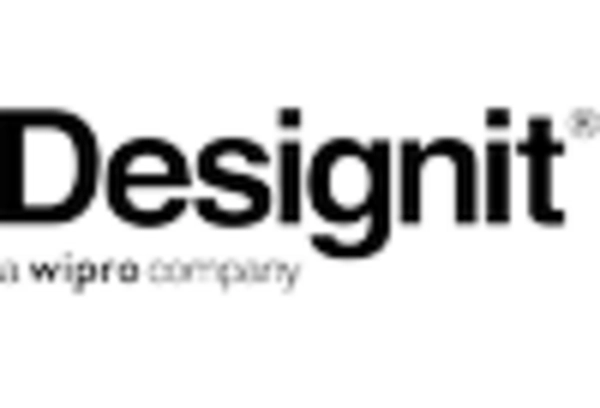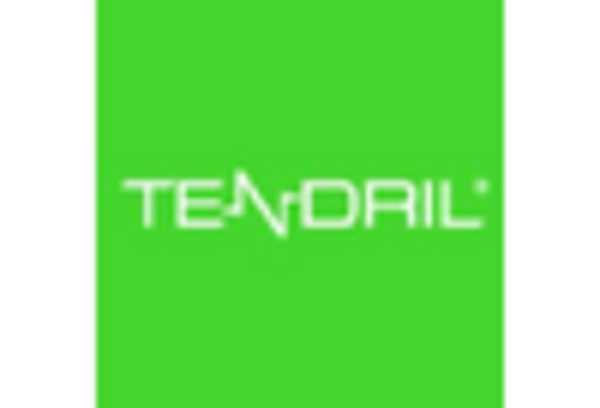Growing Focus on Sustainability
Sustainability has emerged as a pivotal driver within the Product Design & Development Service Market. As environmental concerns gain prominence, consumers and businesses alike are prioritizing eco-friendly products. This shift is prompting companies to adopt sustainable practices in their design and development processes. For example, the use of recyclable materials and energy-efficient manufacturing techniques is becoming increasingly common. Recent studies indicate that products designed with sustainability in mind can command a premium price, with consumers willing to pay up to 30% more for eco-friendly options. This trend not only aligns with consumer values but also enhances brand loyalty. Consequently, companies that integrate sustainability into their product design strategies are likely to experience growth and improved market positioning.
Rising Demand for Customization
The Product Design & Development Service Market experiences a notable increase in demand for customized products. Consumers are increasingly seeking personalized solutions that cater to their specific needs and preferences. This trend is particularly evident in sectors such as consumer electronics and fashion, where tailored designs can significantly enhance user satisfaction. According to recent data, the customization segment is projected to grow at a compound annual growth rate of approximately 15% over the next five years. Companies that can effectively leverage this demand for customization are likely to gain a competitive edge, as they can offer unique products that resonate with individual consumers. This shift towards personalization not only drives innovation within the Product Design & Development Service Market but also encourages businesses to adopt more flexible design processes.
Technological Advancements in Design Tools
The Product Design & Development Service Market is significantly influenced by advancements in design technologies. Innovations such as 3D printing, virtual reality, and artificial intelligence are transforming the way products are conceptualized and developed. These technologies enable designers to create prototypes more efficiently and accurately, reducing time-to-market and costs. For instance, the integration of AI in design processes allows for predictive analytics, which can enhance decision-making and optimize product features based on consumer behavior. As these technologies continue to evolve, they are expected to drive a substantial increase in productivity within the industry. Market analysts suggest that the adoption of advanced design tools could lead to a 20% reduction in development time, thereby allowing companies to respond more swiftly to market demands.
Expansion of E-commerce and Digital Platforms
The expansion of e-commerce and digital platforms is reshaping the Product Design & Development Service Market. As online shopping becomes increasingly prevalent, businesses are adapting their product design strategies to cater to digital consumers. This shift necessitates a focus on user experience and product presentation, as consumers rely heavily on visual appeal and functionality when making purchasing decisions. Data indicates that e-commerce sales are projected to grow by over 20% annually, creating a substantial opportunity for product designers to innovate and enhance their offerings. Furthermore, the rise of social media as a marketing tool allows for direct consumer feedback, enabling designers to refine their products in real-time. Consequently, the integration of e-commerce strategies into product design is likely to drive significant growth and transformation within the industry.
Increased Investment in Research and Development
Investment in research and development (R&D) is a critical driver for the Product Design & Development Service Market. Companies are recognizing the importance of innovation in maintaining competitiveness and meeting evolving consumer demands. Increased R&D spending allows businesses to explore new materials, technologies, and design methodologies, fostering creativity and enhancing product offerings. Data suggests that firms that allocate a higher percentage of their revenue to R&D tend to outperform their competitors in terms of market share and profitability. This trend is particularly evident in industries such as automotive and consumer electronics, where rapid technological advancements necessitate continuous innovation. As companies strive to differentiate themselves, the emphasis on R&D is expected to intensify, further propelling growth within the Product Design & Development Service Market.

















Leave a Comment